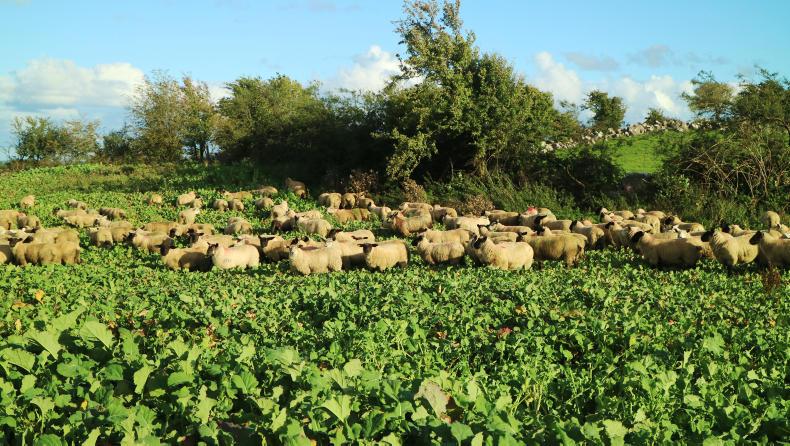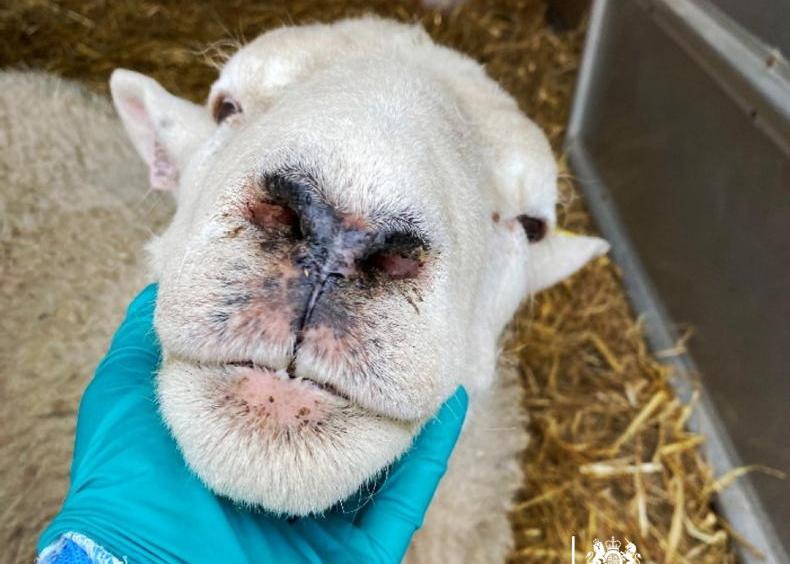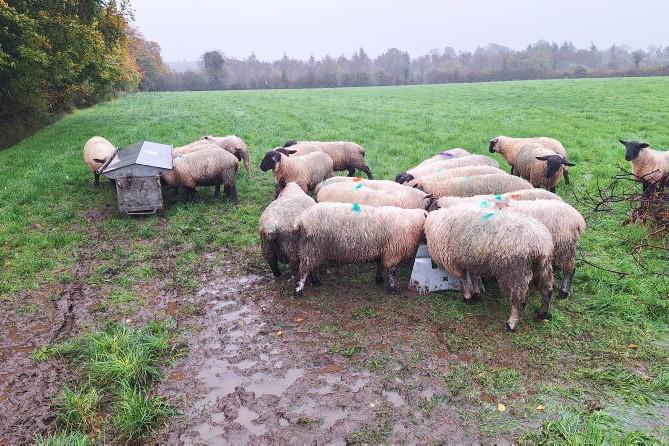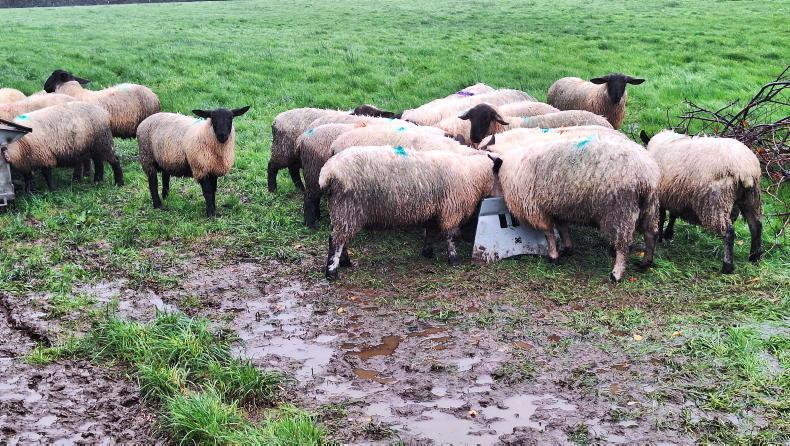Last Wednesday’s farm walk hosted by Roscommon farmer Niall Byrne who farms in Cam, Brideswell, Athlone attracted massive interest with a crowd of over 250 farmers in attendance. The event, jointly organised by Teagasc Roscommon region and Kepak Athleague, focused on finishing lambs on redstart and lamb presentation under the Clean Livestock Policy.
Niall operates a mixed cattle and sheep enterprise on 60ha (148ac) of dry land which is fragmented into four parcels. The cattle to sheep ratio is a 60:40 split with mixed grazing utilised where possible throughout the year. The sheep enterprise comprises a 200-head mid-season lambing ewe flock with replacements homebred. The breeding policy utilises Suffolk and Texel genetics and Niall’s Teagasc adviser James Kelly outlined a top-class system with the flock weaning 1.7 lambs per ewe to the ram.

James Kelly, Teagasc and Niall Byrne.
The cattle system is a mixture of suckler-to-store and beef production with some weanlings also purchased. Niall’s cattle system is focused on breeding good-quality continental cattle with good growth potential.
Redstart introduction
This is the fourth year the farm has grown redstart, a forage crop which is a cross between forage rape and kale. Niall explains he started growing the crop for a number of reasons. He was looking for a means of reducing grass demand and the level of concentrates required to finish lambs while this year the crop has also fitted in well to a land reclamation and reseeding programme.
Teagasc adviser Joe Curtain says interest in forage crops is growing among farmers in the area.
“There has always been a tradition in south Roscommon of growing forage crops to finish lambs or carry ewes over the winter. Farmers operating at a high stocking rate are telling us they are finding it harder to finish lambs without feeding high levels of concentrates and this is generating interest in forage crops again. The cost of concentrates is another factor. If they continue to rise or stay at a higher level then interest in forage crops is likely to grow.”

Redstart showing phosphorus deficieny on the tips of the leaves.
Significant cost
Farmers were told that redstart has the potential to deliver a big volume of dry matter (DM) at a time when demand for grass is rising with this point outlined by Teagasc adviser Noel Mannion.
“The last thing you want at this time of year is lambs competing with ewes for important grass supplies. There has been a trend on many farms in recent years of later lambing so this is resulting in more lambs on farms later in the year. There are two options to manage grass supplies; sell lambs as stores or feed on.”
Noel advised farmers that the crop is not cheap to grow with the crop costing in the region of €200/ac on Niall’s farm with ploughing adding to establishment costs.
“The yield variation is huge and can be anywhere from 5t when sown in May or June on a fertile site to as little as 1t where grown later in the year.” While redstart may be useful in a situation of sowing at a lower cost after tillage for example, late sowing is hard to justify where there are high costs of establishment.
Michael Conroy of Teagasc outlined the importance of maximising yield in terms of reducing the cost of every kg DM produced.
“If we take a cost like in Niall’s case of €200/ac and two bags of nitrogen after each grazing and combine this with a top yield of 5t/ha then the cost per kg of dry matter produced will be about 17c/kg DM. If we compare this to a ration costing €300/t at 85% DM, it will cost about 35c/kg DM. This does not take account of the fact, however, of a land charge or the fact that your field will be out of production from May or June. In Niall’s case, there is an added benefit of building it into a reclamation project which, longer-term, will increase the farm’s production potential.” If the crop is struggling for yield then the economics will swing in the favour of grass and concentrate supplementation for finishing lambs..
Lamb performance
Michael outlined the potential for lambs to double their performance over being grazed on a grass sward which will be declining in feeding value from September onwards.
“Lambs on grass only will gain in the region of 0.4kg to 0.42kg carcase gain at this stage of the year. Lambs grazing redstart have the potential to double this performance, gaining 135g carcase daily or 0.9kg/week. The higher performance stems from a feeding value similar to barley in terms of energy and a protein content of 16% to 18%. The crop has a low DM of 11%-12% but lambs can consume 10kg or 3% of freshweight, which is a phenomenal intake.”
Michael says that the best response is achieved where lambs are grazed that are within five to eight weeks of finishing. “As well as higher performance, lambs will achieve a higher kill-out of 46%-47% where grazing for a few weeks. This is basically due to gut fill. “There is not too much work done on forage crops in Ireland but Scottish work shows a gut fill of 8.5kg for lambs grazed on grass and 5.5kg for lambs grazed on redstart.”
Important considerations
There were a number of important considerations outlined at each of the stops.
Health risks: If lambs are grazed on the crop for longer than four to five weeks then iodine supplementation may be required to prevent a possible deficiency. Clostridial disease vaccination is also recommended to counteract a higher risk from soil intake or grazing during frosty conditions. Soil fertility: The crop will not perform if soil fertility is limiting. Conor Dowling of Teagasc outlined a recommended pH of 6.5 to 7.0. If the pH is under 5.8, he says phosphorus will be locked up and it can result in phosphorus deficiency which is characterised by leaves turning a purple colour. This will limit production with the advice to apply lime where required at sowing along with 40 units of P for index 1 soils; 30 for index 2 soils and 20 units for index 3 soils. Site selection: Utilisation is an important aspect to take account off. Utilisation will suffer on wet soils while these can also present issues for drafting sheep and adhering to the clean livestock policy. Sowing date: Sowing early in the season and splitting the area into sections for rotational grazing is central to achieving three grazings.
Last Wednesday’s farm walk hosted by Roscommon farmer Niall Byrne who farms in Cam, Brideswell, Athlone attracted massive interest with a crowd of over 250 farmers in attendance. The event, jointly organised by Teagasc Roscommon region and Kepak Athleague, focused on finishing lambs on redstart and lamb presentation under the Clean Livestock Policy.
Niall operates a mixed cattle and sheep enterprise on 60ha (148ac) of dry land which is fragmented into four parcels. The cattle to sheep ratio is a 60:40 split with mixed grazing utilised where possible throughout the year. The sheep enterprise comprises a 200-head mid-season lambing ewe flock with replacements homebred. The breeding policy utilises Suffolk and Texel genetics and Niall’s Teagasc adviser James Kelly outlined a top-class system with the flock weaning 1.7 lambs per ewe to the ram.

James Kelly, Teagasc and Niall Byrne.
The cattle system is a mixture of suckler-to-store and beef production with some weanlings also purchased. Niall’s cattle system is focused on breeding good-quality continental cattle with good growth potential.
Redstart introduction
This is the fourth year the farm has grown redstart, a forage crop which is a cross between forage rape and kale. Niall explains he started growing the crop for a number of reasons. He was looking for a means of reducing grass demand and the level of concentrates required to finish lambs while this year the crop has also fitted in well to a land reclamation and reseeding programme.
Teagasc adviser Joe Curtain says interest in forage crops is growing among farmers in the area.
“There has always been a tradition in south Roscommon of growing forage crops to finish lambs or carry ewes over the winter. Farmers operating at a high stocking rate are telling us they are finding it harder to finish lambs without feeding high levels of concentrates and this is generating interest in forage crops again. The cost of concentrates is another factor. If they continue to rise or stay at a higher level then interest in forage crops is likely to grow.”

Redstart showing phosphorus deficieny on the tips of the leaves.
Significant cost
Farmers were told that redstart has the potential to deliver a big volume of dry matter (DM) at a time when demand for grass is rising with this point outlined by Teagasc adviser Noel Mannion.
“The last thing you want at this time of year is lambs competing with ewes for important grass supplies. There has been a trend on many farms in recent years of later lambing so this is resulting in more lambs on farms later in the year. There are two options to manage grass supplies; sell lambs as stores or feed on.”
Noel advised farmers that the crop is not cheap to grow with the crop costing in the region of €200/ac on Niall’s farm with ploughing adding to establishment costs.
“The yield variation is huge and can be anywhere from 5t when sown in May or June on a fertile site to as little as 1t where grown later in the year.” While redstart may be useful in a situation of sowing at a lower cost after tillage for example, late sowing is hard to justify where there are high costs of establishment.
Michael Conroy of Teagasc outlined the importance of maximising yield in terms of reducing the cost of every kg DM produced.
“If we take a cost like in Niall’s case of €200/ac and two bags of nitrogen after each grazing and combine this with a top yield of 5t/ha then the cost per kg of dry matter produced will be about 17c/kg DM. If we compare this to a ration costing €300/t at 85% DM, it will cost about 35c/kg DM. This does not take account of the fact, however, of a land charge or the fact that your field will be out of production from May or June. In Niall’s case, there is an added benefit of building it into a reclamation project which, longer-term, will increase the farm’s production potential.” If the crop is struggling for yield then the economics will swing in the favour of grass and concentrate supplementation for finishing lambs..
Lamb performance
Michael outlined the potential for lambs to double their performance over being grazed on a grass sward which will be declining in feeding value from September onwards.
“Lambs on grass only will gain in the region of 0.4kg to 0.42kg carcase gain at this stage of the year. Lambs grazing redstart have the potential to double this performance, gaining 135g carcase daily or 0.9kg/week. The higher performance stems from a feeding value similar to barley in terms of energy and a protein content of 16% to 18%. The crop has a low DM of 11%-12% but lambs can consume 10kg or 3% of freshweight, which is a phenomenal intake.”
Michael says that the best response is achieved where lambs are grazed that are within five to eight weeks of finishing. “As well as higher performance, lambs will achieve a higher kill-out of 46%-47% where grazing for a few weeks. This is basically due to gut fill. “There is not too much work done on forage crops in Ireland but Scottish work shows a gut fill of 8.5kg for lambs grazed on grass and 5.5kg for lambs grazed on redstart.”
Important considerations
There were a number of important considerations outlined at each of the stops.
Health risks: If lambs are grazed on the crop for longer than four to five weeks then iodine supplementation may be required to prevent a possible deficiency. Clostridial disease vaccination is also recommended to counteract a higher risk from soil intake or grazing during frosty conditions. Soil fertility: The crop will not perform if soil fertility is limiting. Conor Dowling of Teagasc outlined a recommended pH of 6.5 to 7.0. If the pH is under 5.8, he says phosphorus will be locked up and it can result in phosphorus deficiency which is characterised by leaves turning a purple colour. This will limit production with the advice to apply lime where required at sowing along with 40 units of P for index 1 soils; 30 for index 2 soils and 20 units for index 3 soils. Site selection: Utilisation is an important aspect to take account off. Utilisation will suffer on wet soils while these can also present issues for drafting sheep and adhering to the clean livestock policy. Sowing date: Sowing early in the season and splitting the area into sections for rotational grazing is central to achieving three grazings. 











SHARING OPTIONS